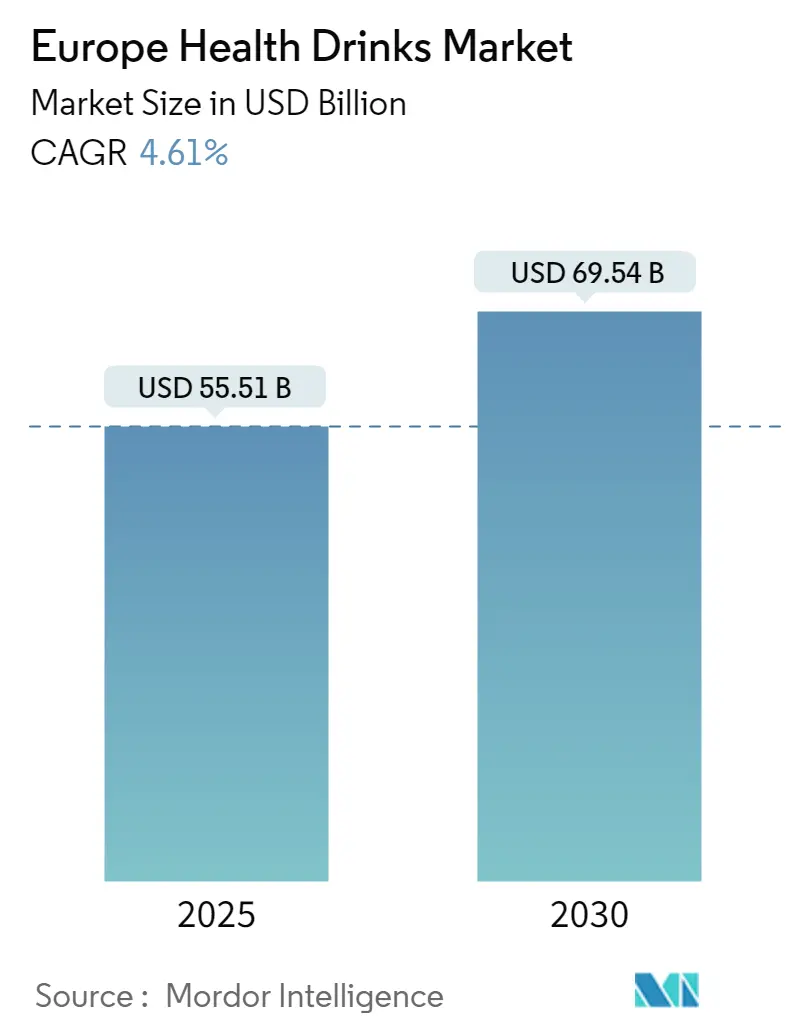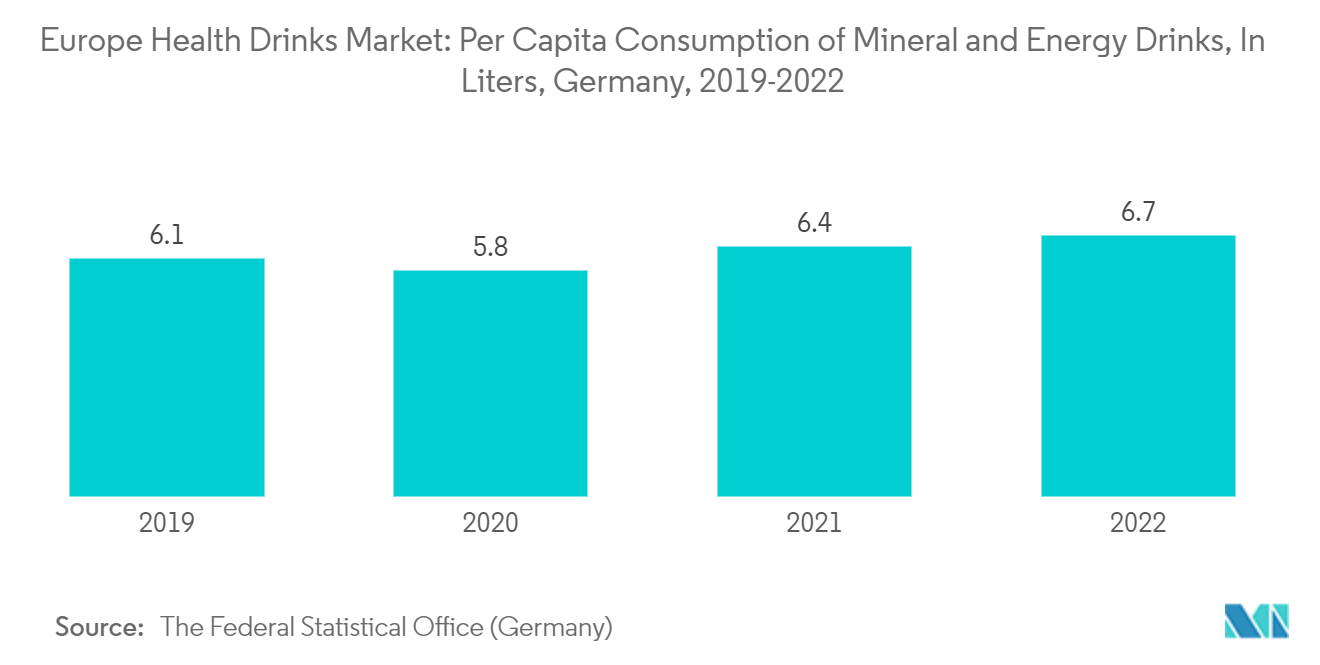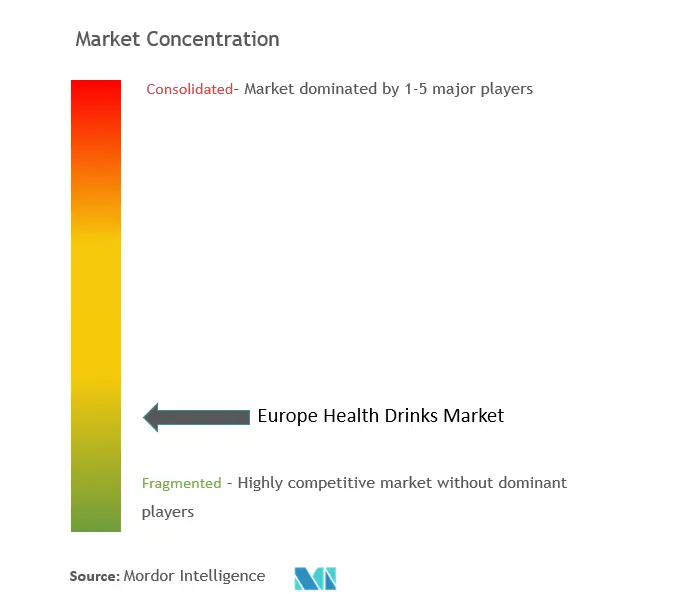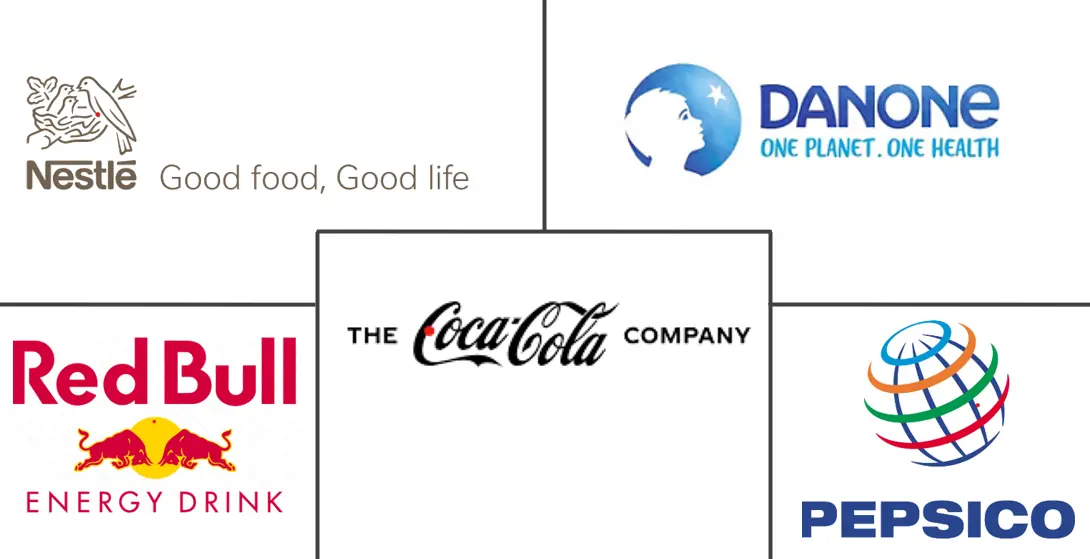Europe Health Drinks Market Size and Share

Europe Health Drinks Market Analysis by Mordor Intelligence
The Europe Health Drinks Market size is estimated at USD 55.51 billion in 2025, and is expected to reach USD 69.54 billion by 2030, at a CAGR of 4.61% during the forecast period (2025-2030).
The market is primarily driven by consumers’ growing inclination toward health and health-based food intake. Consumers are growing more concerned with the veracity of promises as beverages increasingly link themselves to health and disease-preventive messages. The emergence of premium functional beverages is influenced by a variety of industry dynamics and shifting consumer demands from immunity to sustainability.
Moreover, the increasing prevalence of chronic health conditions is prompting consumers to switch from regular beverages. For example, the Public Health England National Health Survey reported that approximately 43.9% of people aged between 40 and 64 years of age in England were diagnosed with type 2 diabetes in 2022-2023. Due to the escalating demand, beverages with health benefits like kombucha, drinkable yogurt, and other products with immunity-boosting and antioxidant properties are gaining popularity. Additionally, consumers are seeking beverages that promote better gut health and digestion, as many individuals struggle with digestive issues.
As more consumers engage in physical activities such as sports and workouts, sports drinks, fortified water, functional water, and energy drinks are also experiencing increased demand. Customers often prefer functional beverages for their perceived advantages, such as rapid energy enhancement. Essentially, consumers are turning to these beverages as alternatives to traditional market offerings. The industry is divided, with a multitude of companies providing a wide range of health-focused drinks, such as Red Bull GmbH, Danone SA, Suntory Holdings Limited, and PepsiCo Inc. For instance, in March 2023, Suntory Holdings' Lucozade Sports brand introduced a new sugar-free sports beverage in the UK market, featuring Orange & Peach and Raspberry & Passion Fruit flavors. Such factors drive the growth of health drinks in the regional market.
Europe Health Drinks Market Trends and Insights
Growing Popularity of Energy Drinks Driving the Market
The convenience of energy drinks being portable makes them a suitable choice for individuals with busy lifestyles who are always on the move. As people work longer hours, they often rely on energy drinks to combat fatigue and stay alert during demanding schedules. This lifestyle trend has led to an increased demand for energy drinks among Europeans, which in turn supports the sales of energy drinks in European countries. Additionally, the rise in sports participation and the growing emphasis on health and fitness have contributed to the market growth of sports drinks in Europe. For instance, according to the Ministry of Culture and Sport's Survey of Sporting Habits, in 2022, 57.3% of the Spanish population aged 15 years and older engaged in sports activities. This aligns with the need for quick energy replenishment during physical activities, increasing the popularity of energy drink brands.
To cater to consumer preferences, manufacturers like Red Bull and Monster Beverages offer their energy drinks in various flavors and packaging options, such as PET bottles and cans. These companies also introduce new flavors, including Classic Cola, Tropical, and Exotic, along with berry and citrus varieties, to further enhance sales. For instance, in July 2023, German social media star MontanaBlack launched a new calorie-free energy drink called GÖNRGY in collaboration with REWE and Kaufland. The drink was made available in three flavors: Raspberry Cheesecake, Blueberry Coconut, and Tropical Exotic. This trend of on-the-go consumption, coupled with innovative packaging and flavor options, contributes to the growth of energy drinks in the region.

The United Kingdom Holds a Dominant Market Share in Health Drinks
Wellness and health trends have encouraged an increasing number of consumers to opt for healthy beverages like fruit and vegetable juices and fortified bottled water. Changes in dietary habits and lifestyles among UK consumers, mainly youngsters, along with a growing inclination toward healthy drinks, are driving the increased consumption of fruit and vegetable juices and other healthy beverages. British consumers are switching to healthy drinks that are free from added sugar because of health concerns like diabetes. Thus, market players have been involved in offering organic, sugar-free, and preservative-free health drinks. For instance, in August 2022, plant-based drinks brand Plenish launched a fruit and vegetable juice called “Rise.” The company claimed that the juice was packed with 100% organic fruit and vegetables and was free from any sweeteners, preservatives, or stabilizers.
With rising disposable incomes, British consumers are spending more on functional wellness drinks and are looking for ways to decrease mental fatigue and increase energy levels, thus driving the demand for health drinks. For instance, according to the British Soft Drink Association, the consumption of sports and energy drinks increased from 906 million liters in 2021 to 978 million liters in 2022. Major industry players are introducing innovative health beverages in various flavors, including herbal flavors, to cater to consumers with varying taste palettes. As a result, the demand for functional beverages in the United Kingdom is growing as people are becoming more concerned about their health.

Competitive Landscape
The European health drinks market is competitive due to multiple regional and multinational companies offering a wide range of products and trying to maintain their leadership position in the market studied. The key players in the market include Nestlé SA, PepsiCo Inc., Red Bull GmbH, Danone SA, and The Coca-Cola Company. The market players are embarking on business strategies, including product innovations, partnerships, strengthening their hold over online and offline marketing, and mergers & acquisitions to expand their visibility and portfolio of offerings, thus augmenting the growth of the market. For instance, in March 2023, Red Bull expanded its Summer Edition line with the launch of a new Juneberry flavor energy drink. The company claims to create excitement among consumers as flavors are a key driver of growth in the sports and energy drinks category.
Europe Health Drinks Industry Leaders
-
Nestlé S.A.
-
PepsiCo. Inc.
-
Red Bull GmbH
-
Danone S.A.
-
The Coca-Cola Company
- *Disclaimer: Major Players sorted in no particular order

Recent Industry Developments
- January 2024: Celsius Holdings, an energy drink manufacturer based in Florida, United States, broadened its international reach with distribution deals in the United Kingdom. Celsius named Suntory Beverage & Food Great Britain as its exclusive sales and distribution partner to enter the Irish and UK markets. The energy drinks maker has identified Germany and other European countries as “big opportunities” for new markets as it increases its reach outside the United States.
- August 2023: FC Bayern Munich announced its partnership with Logan Paul and KSI’s popular beverage brand, PRIME. The PRIME’s flagship product, Hydration, a sports drink alternative, was the official isotonic partner for the club of 33-time German champions.
- March 2023: Boost launched a limited-edition flavored sports drink- Raspberry and Mango. The launch was to be supported by an exclusive competition in collaboration with Leeds United Football Club. The packaging used the same theme as other flavors in the range, with distinct shades of purple to highlight the flavor.
Europe Health Drinks Market Report Scope
Health drinks are non-alcoholic drinks containing vitamins, minerals, probiotics, dietary fibers, and other nutrients.
The European health drinks market is segmented by type, distribution channel, and geography. By type, the market is segmented into fruit and vegetable juices, sports drinks, energy drinks, kombucha drinks, functional and fortified bottled water, dairy and dairy alternative drinks, and RTD tea and coffee. By distribution channel, the market is segmented into on-trade and off-trade. By off-trade, the market is further sub-segmented into supermarkets/hypermarkets, convenience/grocery stores, online stores, and other off-trade channels. By geography, the market is segmented into the United Kingdom, Germany, France, Spain, Italy, Belgium, the Netherlands, and the Rest of Europe. For each segment, the market sizes and forecasts have been offered based on value (USD).
| Fruit and Vegetable Juices |
| Sports Drinks |
| Energy Drinks |
| Kombucha Drinks |
| Functional and Fortified Bottled Water |
| Dairy and Dairy Alternative Drinks |
| RTD Tea and Coffee |
| On-trade | |
| Off-trade | Supermarkets/Hypermarkets |
| Convenience/Grocery Stores | |
| Online Stores | |
| Other Off-trade Channels |
| United Kingdom |
| Germany |
| France |
| Spain |
| Italy |
| Belgium |
| Netherlands |
| Rest of Europe |
| Type | Fruit and Vegetable Juices | |
| Sports Drinks | ||
| Energy Drinks | ||
| Kombucha Drinks | ||
| Functional and Fortified Bottled Water | ||
| Dairy and Dairy Alternative Drinks | ||
| RTD Tea and Coffee | ||
| Distribution Channel | On-trade | |
| Off-trade | Supermarkets/Hypermarkets | |
| Convenience/Grocery Stores | ||
| Online Stores | ||
| Other Off-trade Channels | ||
| Geography | United Kingdom | |
| Germany | ||
| France | ||
| Spain | ||
| Italy | ||
| Belgium | ||
| Netherlands | ||
| Rest of Europe | ||
Key Questions Answered in the Report
How big is the Europe Health Drinks Market?
The Europe Health Drinks Market size is expected to reach USD 55.51 billion in 2025 and grow at a CAGR of 4.61% to reach USD 69.54 billion by 2030.
What is the current Europe Health Drinks Market size?
In 2025, the Europe Health Drinks Market size is expected to reach USD 55.51 billion.
Who are the key players in Europe Health Drinks Market?
Nestlé S.A., PepsiCo. Inc., Red Bull GmbH, Danone S.A. and The Coca-Cola Company are the major companies operating in the Europe Health Drinks Market.
What years does this Europe Health Drinks Market cover, and what was the market size in 2024?
In 2024, the Europe Health Drinks Market size was estimated at USD 52.95 billion. The report covers the Europe Health Drinks Market historical market size for years: 2019, 2020, 2021, 2022, 2023 and 2024. The report also forecasts the Europe Health Drinks Market size for years: 2025, 2026, 2027, 2028, 2029 and 2030.
Page last updated on:
Europe Health Drinks Market Report
Statistics for the 2025 Europe Health Drinks market share, size and revenue growth rate, created by Mordor Intelligence™ Industry Reports. Europe Health Drinks analysis includes a market forecast outlook for 2025 to 2030 and historical overview. Get a sample of this industry analysis as a free report PDF download.



